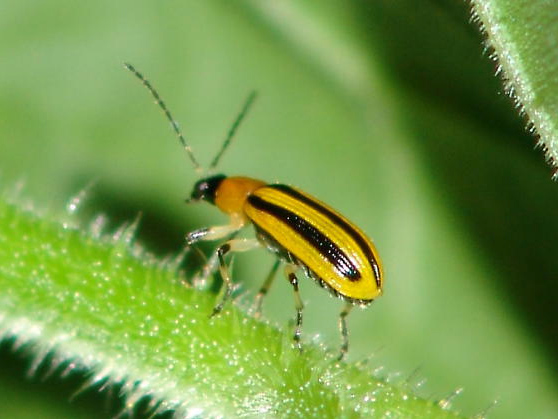Increases in ground-level ozone, especially in rural areas, may interfere not only with plant-eating insects’ ability to find host plants, but also with pollinators finding flowers, according to researchers from the University of Virginia and Pennsylvania State University.
“Ozone pollution has great potential to perniciously alter key interactions between plants and animals,” the researchers wrote in the current issue of Environmental Research Letters.
The animal tested in this case was the striped cucumber beetle, a predator of cucurbits – cucumbers, squashes, pumpkins and melons. These insects dine on the plants from the moment they emerge from the ground; when fruit forms, they eat that as well.
“Insects detect odor with olfactory receptors located on their antennae,” said Jose D. Fuentes, a professor of meteorology at Penn State who formerly was an environmental scientist at U.Va. “These receptors sense plant-emitted volatile organic compounds in very small amounts – as low as six molecules hitting an antenna.”
However, ozone, which is a very reactive substance, degrades the volatile organic compounds when they mix to the point where they no longer stimulate the olfactory system.
“Insects rely on scent to find food. While some insects are agricultural pests, many perform valuable functions like pollination and control of pest insects,” said T’ai Roulston, research associate professor of environmental sciences in the College of Arts & Sciences and curator at U.Va.’s Blandy Experimental Farm. “If pollution disrupts their ability to use their sense of smell, they will find food less efficiently and may pollinate less, thus reducing fruit production.”
Fuentes, Roulston and Penn State undergraduate meteorology student John Zenker tested the beetles in an enclosed Y-tube apparatus so that the insects could choose which branch to take. The researchers collected the insects from pumpkin and squash plants. They tested the insects using buffalo gourd plants, a naturally growing wild gourd that likes semi-arid areas.
Separate air streams flowed into the two branches of the Y-tube. Choices of air in each tube were ambient filtered air, ambient filtered air plus up to 120 parts-per-billion ozone, ambient filtered air plus volatile organic compounds, or air plus up to 120 parts-per-billion ozone and volatile organic compounds from the plant. To obtain this mix, or only ozone or volatile organic compounds, that branch flowed either to a plant chamber or ozone generator or both.
The researchers tested the insects with all ambient air, with ambient air and ozone, with ambient air and volatile organic compounds, and with ambient air and a mix of ozone and volatile organic compounds. When presented with an ambient air or volatile organic compound airstream, the beetles chose the volatile organic compound tube 80 percent of the time.
“However, as the ozone levels increased, they chose the path to the flower less frequently,” Fuentes said. “By the time the mix contained 80 parts-per-billion ozone, the beetles showed no preference for either tube.”
The researchers also tested the beetles with volatile organic compounds and a mix of volatile organic compounds and ozone. At low ozone levels, the insects showed no preference, but as ozone levels increased, the insects increasingly preferred the ozone-free path. At 80 parts-per-billion, the beetles chose the volatile organic compounds without ozone significantly more often than the ozonized mixture.
While one might think that higher ozone levels in the lower atmosphere would improve crops because predator insects would be unable to find their hosts, the additional ozone would also interfere with mutualistic insect plant responses such as pollination.
The National Science Foundation supported this research.
Media Contact
Article Information
April 11, 2013
/content/ozone-masks-plants-volatiles-confusing-plant-eating-insects-and-pollinators

